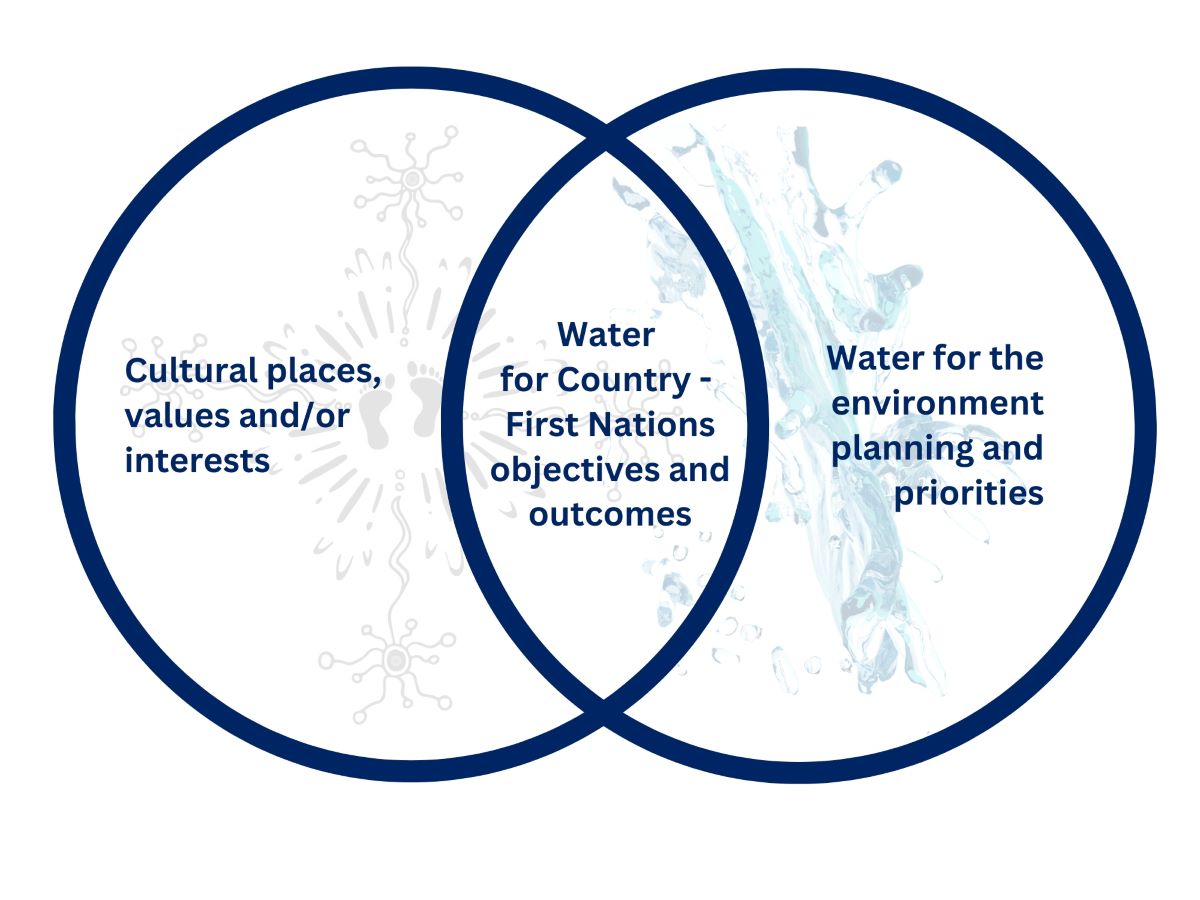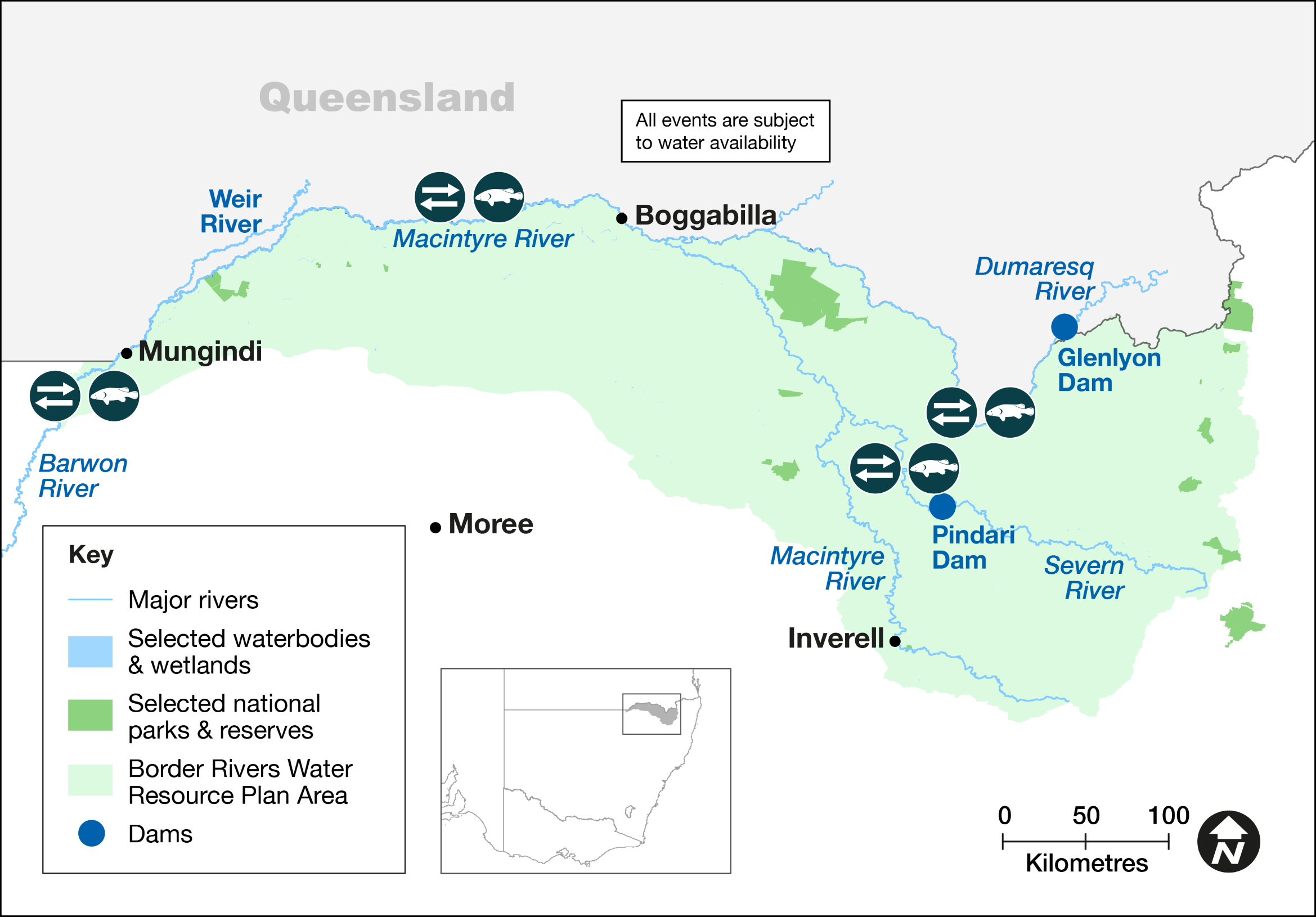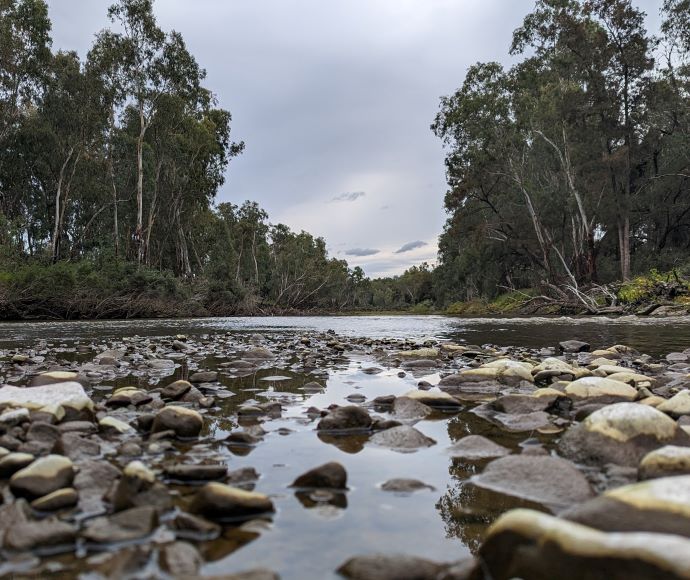Water that is allocated and managed specifically to improve the health of rivers, wetlands and floodplains is known as water for the environment.
NSW environmental water management teams work with local communities, Aboriginal representatives, partner agencies, and other stakeholders to develop detailed annual plans for the use of water for the environment in each catchment, including how its use is prioritised.
The catchment
The NSW Border Rivers catchment covers an area of 24,000 km2. The catchment hugs the Queensland border and is influenced by the management of water on both sides of the border.
Pindari Dam, on the Severn River (NSW), and Glenlyon Dam, on Pike Creek (Queensland), are 2 of the major water storages influencing the catchment. Morella Watercourse, Boobera Lagoon and Pungbougal Lagoon located on the Macintyre River floodplain are important cultural sites for Aboriginal people. These wetlands are also listed as a site of national importance in the Directory of Important Wetlands in Australia.
The Border Rivers catchment is Country to the Bigambul, Euahlayi, Githabul, Kambuwal, Gomeroi/Kamilaroi, Kwiambul, and Ngarabal Aboriginal people.
Water for rivers and wetlands
Following wet years in 2021 and 2022, the weather outlook for 2023 is dry and warm, signalling a possible return to dry conditions.
Flow records show that despite recent wet years, base flows needed to continue for a longer period to achieve ecological connectivity with the Barwon River. Similarly, large freshes are not being observed often enough to optimise fish outcomes.
In 2023–24, water managers will focus on supporting native fish populations in the Severn, Dumaresq, Macintyre and upper Barwon rivers.
With healthy account balances as of 1 July 2023, the Department of Climate Change, Energy, the Environment and Water (the department) can set aside water for use in future years to support the longer-term resilience of the catchment through drier times.
Aboriginal water management priorities
Water for Country is environmental water use planned by the department and Aboriginal people to achieve shared benefits for the environment and cultural places, values and/ or interests.
Water managers will partner with Aboriginal knowledge holders and organisations to monitor and manage the use of environmental water in the catchment. This work will be centred around, but not limited to, the availability and use of the Pindari Stimulus Flow account.
Initial planning has begun with Aboriginal knowledge holders and organisations to better describe cultural and environmental water requirements of aquatic fauna.

Environmental water managers have been working to support Aboriginal people’s priorities in water management.
Weather and water forecast
As at early June the El Niño–Southern Oscillation (ENSO1) outlook is neutral, with an El Niño watch. This means that while the El Niño–Southern Oscillation is currently neutral, there is a 50% chance that an El Niño may develop later in 2023. This is about twice the normal likelihood. El Niño typically brings hot, dry conditions to Australia, often leading to drought and bushfires.
The short-term rainfall outlook is likely to be below median for the Border Rivers which will be enough to maintain the current soil moisture and run-off efficiency in the catchment, with dam levels remaining high.
Water managers have prepared watering plans that consider a range of weather and water availability scenarios. This is known as resource availability scenario planning. The Border Rivers catchment outlook is rated as dry for the 2023–24 water year.
1. ENSO: The interaction between the sea surface and atmosphere over the Pacific Ocean which results in dryer (El Nino) or wetter (La Nina) conditions.
Resource availability scenario
Current forecast: Dry
| Conditions | Main aim | Other aims |
|---|---|---|
| Very dry | Protect | Avoid critical loss Maintain key refuges Avoid catastrophic events |
| Dry | Maintain | Maintain river functioning Maintain key functions of high priority wetlands |
| Moderate | Recover | Improve ecological health and resilience Improve opportunities for plants and animals to breed, move and thrive |
| Wet to very wet | Enhance | Restore key floodplain and wetland linkages Enhance opportunities for plants and animals to breed, move and thrive |
Key planned actions for 2023–24
Native fish
Water managers may use water for the environment to support native fish movement, breeding and recruitment outcomes in the Dumaresq River downstream of Glenlyon Dam and in the Severn and Macintyre rivers downstream of Pindari Dam.
If used, the Pindari Stimulus flow would most likely occur in spring as a large fresh event at Ashford. This will benefit native fish breeding, recruitment and dispersal.
Baseflow events provide fish with the opportunity for movement and population mixing.
Vegetation
Providing a further benefit, flows delivered under the connectivity and native fish actions will be managed to maximise benefits to riparian and aquatic vegetation.
Connectivity
If more water becomes available, water managers may use available held water for the environment to provide a low connection flow along the Dumaresq and Macintyre–Barwon system to replenish and refresh pools.
If moderate sized natural events occur, water managers may deliver water for the environment to extend the duration of the event and/or increase the distance this water will reach downstream. If practical, water managers may release held water for the environment to increase the peak flow rate and to inundate higher benches and low anabranches and their connected wetlands.
If larger natural events occur, the use of NSW’s held supplementary and Queensland’s unsupplemented licences can retain a proportion of these flows instream.
Map of proposed annual priority targets in the water resource plan area 2023–24

Map of Border Rivers catchment area showing priority targets for environmental water to be delivered to in 2023–24
The department is supporting the health and resilience of rivers and wetlands by delivering water for the environment where and when it is needed. We use the best available science, management expertise and experience to manage water across the landscape. This statement of annual priorities identifies the waterways and wetlands that are likely to receive water.
Our decision-making process considers:
- expected availability of water in the coming year
- conditions of the previous year
- current health of the plants and animals in these ecosystems.
Water for the environment delivers benefits for communities, rivers, wetlands and wildlife across New South Wales.
Healthy, connected rivers and floodplains are a focus for tourism, fishing, recreation and relaxation. Rivers carry water to our homes, schools, farms and businesses, and along the way, support countless species including native fish, waterbirds, frogs, plants and more.
Rivers and wetlands have great cultural and spiritual significance for Aboriginal people.
Water for the environment is a critical tool to maintain and enhance the rivers, wetlands and wildlife we all love.
Working with communities
Local communities are at the heart of everything we do.
We involve the broader community by holding site tours and forums, and online and in-person events.
In catchments that have community-based environmental water advisory groups, NSW water management teams consult with them regularly.
Environmental water advisory group members include local landholders, recreational fishers, Aboriginal people and local government representatives. Their advice helps to inform the decisions made by our local environmental water management teams.
The Border Rivers catchment doesn't currently have an environmental water advisory group, but the Department of Climate Change, Energy, the Environment and Water is in the process of developing one.
Expected environmental water volumes available at 1 July 2023
The Department of Climate Change, Energy, the Environment and Water works with partner agencies to manage environmental water in the catchment.
Planned environmental water
| Source | Maximum volume available (gigalitres) | Volume expected 1 July under current conditions (gigalitres) |
|---|---|---|
| Discretionary Planned Environmental – Pindari Stimulus Flow | 8.0 | 8.0 |
Water licenced to the Commonwealth
| Source | Maximum volume available (gigalitres) | Volume expected 1 July under current conditions (gigalitres) |
|---|---|---|
| General security | 2.806 | 2.806 |
| Supplementary | 1.437 | Event-dependent |
| Medium (Qld) | 15.54 | 15.54 |
| Unsupplemented (Qld) | 19.986 | Event-dependent |
Note: This is an indicative summary of expected volumes to be available. For further detail and information on available volumes, please contact the region via Department of Climate Change, Energy, the Environment and Water enquiries on 1300 361 967.
1 gigalitre = 1000 megalitres; 2.5 megalitre = 1 Olympic swimming pool.
Outcomes of water for the environment
Water for the environment has been delivering outcomes for rivers, wetlands and wildlife for 30 years.
We deliver flows that:
- trigger native fish to breed and move
- support waterbirds to nest and feed
- connect rivers and floodplains
- water forests and floodplains
- allow plants to grow, flower and set seed
- create refuge during droughts
- enhance outcomes during wetter times
- release vital nutrients from the floodplain floor that underpin the aquatic food web.
It's habitat restoration on a landscape scale.

Looking upstream, Dumaresq River, Bonshaw
More information on planned and past watering events
- Annual environmental water priorities in the Border Rivers catchment 2022–23
- Border Rivers – Water for the environment: Annual priorities 2021–22
- Border Rivers catchment: Annual environmental watering priorities 2020–21
- Border Rivers: Annual environmental watering priorities 2019–20
- Water for environment outcomes 2022–23
- Water for environment outcomes 2021–22
- Use of water for the environment in NSW: Outcomes 2020–21
- Use of water for the environment in NSW: Outcomes 2019–20
- Use of water for the environment in NSW: Outcomes 2018–19